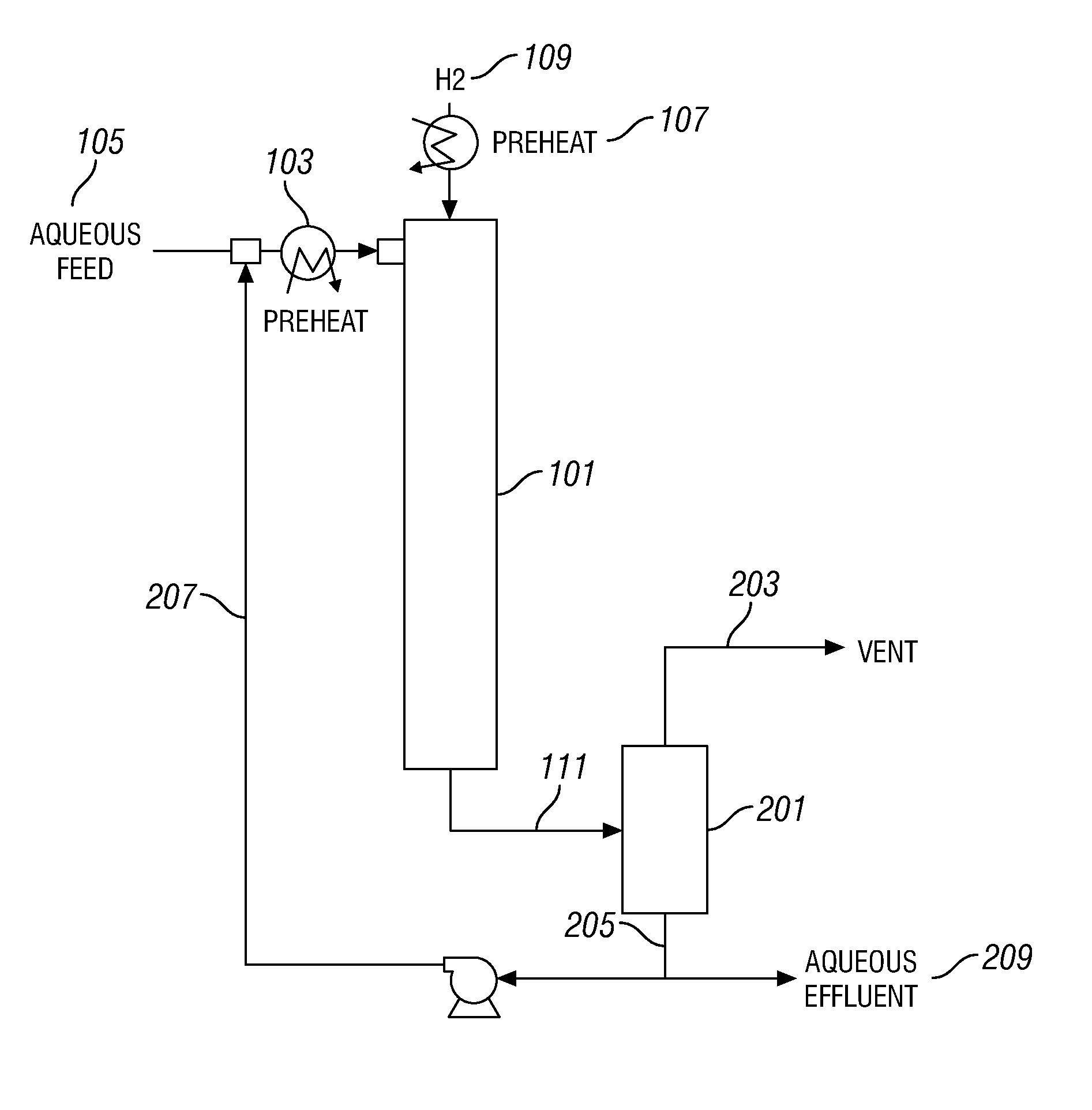Aqueous catalyst sulfiding process
- Summary
- Abstract
- Description
- Claims
- Application Information
AI Technical Summary
Benefits of technology
Problems solved by technology
Method used
Image
Examples
examples
[0039]Catalyst activation and sulfiding studies were conducted in a Parr5000 Hastelloy multireactor comprising 6×75-milliliter reactors operated in parallel at pressures up to 135 bar, and temperatures up to 275° C., stirred by magnetic stir bar. Alternate studies were conducted in 100-ml Parr4750 reactors, with mixing by top-driven stir shaft impeller, also capable of 135 bar and 275° C.
[0040]Reaction samples were analyzed for sugar, polyol, and organic acids using an HPLC method entailing a Bio-Rad Aminex HPX-87H column (300 mm×7.8 mm) operated at 0.6 ml / minute of a mobile phase of 5 mM sulfuric acid in water, at an oven temperature of 30° C., a run time of 70 minutes, and both RI and UV (320 nm) detectors.
[0041]Product formation (mono-oxygenates, diols, alkanes, acids) were monitored via a gas chromatographic (GC) method “DB5-ox”, entailing a 60-m×0.32 mm ID DB-5 column of 1 um thickness, with 50:1 split ratio, 2 ml / min helium flow, and column oven at 40° C. for 8 minutes, follow...
examples 1 & 2
Examples 1& 2
Aqueous NaHS Activation
[0042]For example 1, a Parr 5000 reactor was charged with 0.498 grams of nickel-promoted cobalt oxide—molybdate / alumina catalyst (DC-2533 from Criterion Catalyst & Technologies L.P.), and 0.602 grams of sodium hydrogen sulfide (NaHS) from Sigma-Aldrich Co. A second reactor (example 2) was charged with 0.503 grams of the same nickel-promoted cobalt oxide—molybdate / alumina catalyst, with no NaHS. 20.0 milliliters of a solution of 20% by weight glycerol in deionized water were added to each reactor, before pressuring to 52 bar with H2, and heating to 240° C. for 20 hours. Concentrations of reaction product were determined by DB5-ox GC method, and HPLC analysis.
[0043]Conversion of glycerol for example 1 (with added sodium hydrogen sulfide) corresponded to a first order rate constant of 2.7 l / h / wt-fraction catalyst, with 1,2-propylene glycol the principal product detected. Glycerol conversion for example 2 (no sodium hydrogen sulfide) corresponded to a...
examples 3 & 4
[0045]0.5 grams of nickel-promoted cobalt oxide-molybdate / alumina catalyst were treated with 25-grams of 10% cysteine in deionized water, overnight at 240 C. 0.26 grams of the resulting treated catalyst were charged with a mixture of 25% glycerol and 25% sorbitol in deionized water, and 60 psi of H2, before heating to 250 C for 5 hours. HPLC and DB %-ox analysis indicated conversion of glycerol to propylene glycol and mono-oxygenates at a rate of 2.2 l / h / wt. A companion run (example 4) using fresh nickel-promoted cobalt-oxide molybdate / alumina catalyst which had not been subjected to preactivation with cysteine, gave no measurable conversion of glycerol. This example demonstrates the ability of cysteine to active a cobalt molybdate catalyst to effect hydrogenolysis and hydro-deoxygenation reactions.
PUM
| Property | Measurement | Unit |
|---|---|---|
| temperature | aaaaa | aaaaa |
| temperature | aaaaa | aaaaa |
| pressure | aaaaa | aaaaa |
Abstract
Description
Claims
Application Information
 Login to View More
Login to View More - R&D
- Intellectual Property
- Life Sciences
- Materials
- Tech Scout
- Unparalleled Data Quality
- Higher Quality Content
- 60% Fewer Hallucinations
Browse by: Latest US Patents, China's latest patents, Technical Efficacy Thesaurus, Application Domain, Technology Topic, Popular Technical Reports.
© 2025 PatSnap. All rights reserved.Legal|Privacy policy|Modern Slavery Act Transparency Statement|Sitemap|About US| Contact US: help@patsnap.com


